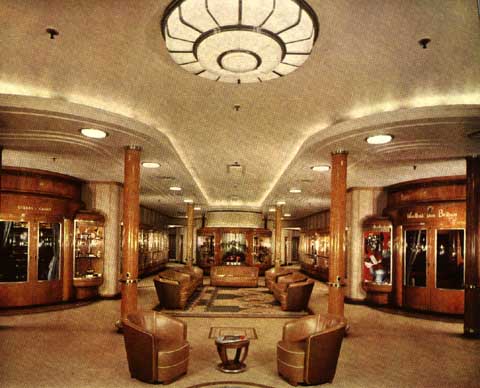
There were originally only four small shops aboard the Queen Mary. Three were located in first class and one was in second class. After the war others were added.

The Main Hall with the three original
shops in 1947 just after the Queen
Mary was refitted following World War II service. Notice the two tone hide
wall treatment replacing the pre-war oak veneer, and the golden tan
linoleum replacing the pre-war two tone green and cream.
Once the Queen Mary came to Long Beach to serve as a commercial tourist attraction its new owner, the City of Long Beach significantly expanded retail operations aboard the ship.
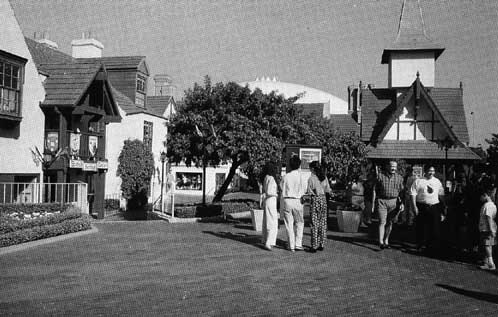
The "Londontowne-style" village
After more than twenty-five years of essentially the same approach, we believe that it is time to reconsider the retail strategy on both the ship and the property. We believe it is time to begin to create one that emphasizes the uniqueness of the great liner and its collections.
Learning from the experience of Colonial Williamsburg
The oldest and most commercially successful retail and merchandising museum program in the world is that of Colonial Williamsburg, named for the restored area of the colonial capital of Virginia. In the late 1920’s and early 1930’s the core of the historic area was assembled and restored by John D. Rockefeller.
Rather than simply leasing out the shops, inns and cottages and permitting the lessees to "logo" and sell whatever quaint looking merchandise they could, Colonial Williamsburg, aided not doubt by the high standards and deep pockets of the Rockefellers, approached the matter completely differently.
Initially there was no intent to sell these items. They were created for operational use. But patrons began asking where they might purchase the lovely china they just ate off, and where they might purchase the beautifully crafted reproduction furniture they sat on.
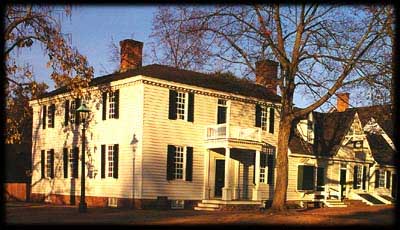
House and attached shop on Duke of Gloucester Street in the historic district.
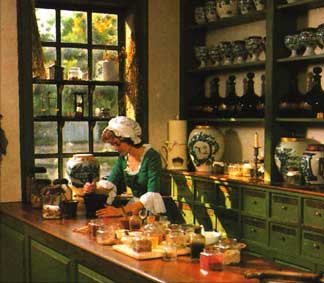 The Colonial Williamsburg Foundation decided to license their official
suppliers. For the privilege, the manufacturers pay a percentage from all retail sales to
the foundation that is used to support its cultural and educational mission. As a result
of outstanding design and consistently quality of their products, the demand for Colonial
Williamsburg, Inc.’s products have been consistently strong worldwide. "Craft
House," a showcase for all of the official manufacturers was built adjacent to
the restored area. Over the years the list of manufacturers and items manufactured has
expanded and evolved. Items designed for direct sale are now part of the program. The
hotels and visitor information center run by the foundation have gift shops in them. Here
a broader set of well designed and manufactured merchandise is sold including the
ubiquitous tee shirts and post cards.
The Colonial Williamsburg Foundation decided to license their official
suppliers. For the privilege, the manufacturers pay a percentage from all retail sales to
the foundation that is used to support its cultural and educational mission. As a result
of outstanding design and consistently quality of their products, the demand for Colonial
Williamsburg, Inc.’s products have been consistently strong worldwide. "Craft
House," a showcase for all of the official manufacturers was built adjacent to
the restored area. Over the years the list of manufacturers and items manufactured has
expanded and evolved. Items designed for direct sale are now part of the program. The
hotels and visitor information center run by the foundation have gift shops in them. Here
a broader set of well designed and manufactured merchandise is sold including the
ubiquitous tee shirts and post cards.
Finally in Merchant’s Square, a period retail area adjacent to the restored area, is located a collection of fine shops that are leased to some of the world’s most famous merchants.
It is worth noting that of the three major categories of shops listed above the museum shops are the most profitable.
Adapting the strategy to the Queen Mary
If one were to adapt the approach used so successfully by Colonial Williamsburg to the Queen Mary how might this affect retailing and merchandising on the ship and property?
The shops aboard the ship would be clearly differentiated from the leased gift shops elsewhere on property. They are part of the paid attraction. They serve an educational and cultural role as well as a retail role. As part of "the Queen Mary Experience," their role is to sell while telling the story of the Queen Mary.
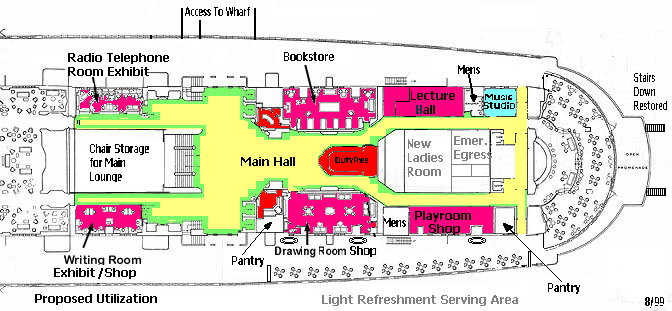
Possible retail configuration on Promenade Deck
We see the three original shops on the Main Hall continuing to function as small shops with merchandise carefully selected to enhance the setting.
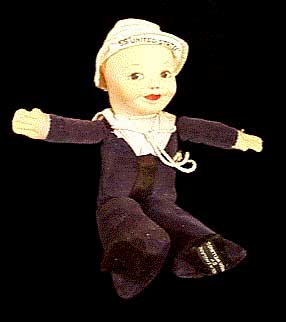
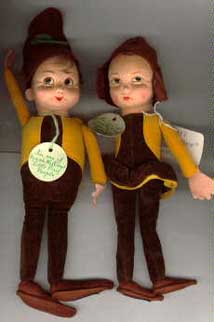
Norah Wellings' Character Dolls
In addition to the three original shops, we see:
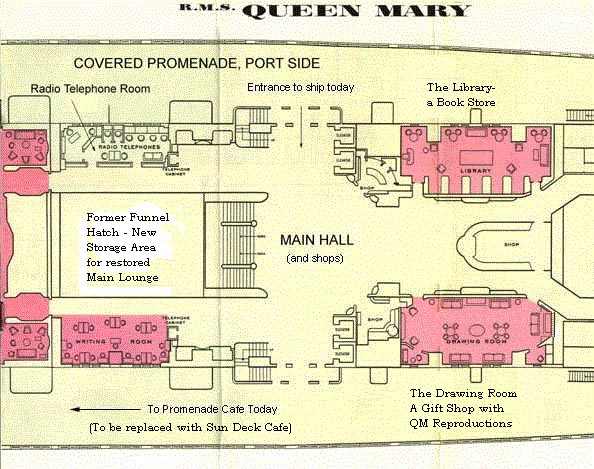
A possible future arrangement of shops and services on Promenade deck
Showcases and Storerooms
For shops on Promenade Deck such as the drawing room and children’s playroom to function as showcases, masses of duplicative merchandise cannot be piled into them. So when a client wishes to purchase for example 10 place settings of Queen Mary dinnerware or a pair of deck chairs, they complete the sales transaction on promenade deck but pick up their merchandise when they leave the ship. From the wharfside they enter Hold # 2 where they see the vast cargo hold of the ship in use today. This vast cargo hold might become a retail area in and of itself – called "Stores of the Queen."
Developing a Merchandise Program
We see a number of lines of merchandise that could be developed to reproduce original (and adaptations of original) items in the Queen Mary collection and of other great liners. These include dinnerware, furniture, art, linens, etc. These Queen Mary exclusives might be sold both on the ship and property, through designers, catalogs and worldwide via the Internet. This merchandise might also be used in the operations of the ship– an example of supportive cross selling.
There are already excellent examples of this type of merchandising – some by original manufacturers of Queen Mary artifacts. For example:

Stuart Crystal glasses as used on Cunard ships
Likewise there is a Harland and Wolff Titanic Maritime Collection – including reproductions of the glassware by another contemporary manufacturer. This collection can be viewed at: http://www.steamertrunkmerchants.com
Leased Gift Shops
Leased shops might be built on the property but off the ship. Perhaps an art deco rendition of the famed Burlington Arcade of London might be incorporated into the proposed Visitors' Information Center to house them. Here a fine collection of famous shops might be assembled.
Mass Tourist Merchandise
The ubiquitous tee shirts, posters and other "logoed" trinkets that are the found in most common tourist properties can have a place on the property. There is clearly interest in this type of merchandise. However, when it is allowed to set the tone and swamp retailing on a historic property, we believe it makes the visitor’s experience commonplace and hence discourages repeat business.
We see a very clear distinction between mundane merchandise and inexpensive, but well designed and selected keepsakes. An excellent example of the latter is the merchandise in the gift shop associated with the Ronald Reagan Presidential Library.
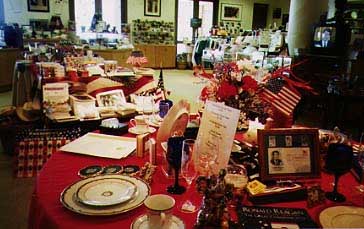 When the shop was established Mrs. Reagan set
up a rule of thumb for the shop’s buyers. They would only sell things that either she
or the President would be proud to give to someone. The result of this stringent policy is
a wonderful array of creative merchandise in a wide variety of price ranges. The shop
sells everything from jelly beans for a few pennies to White House note pads, to exact
reprints of menus from state dinners, to entire place settings of the Reagan presidential
china - made by the original manufacturer. The shop is both internationally famous and
very financially successful. (You can visit the Reagan Library web site at:
http://www.reaganlibrary.net.
When the shop was established Mrs. Reagan set
up a rule of thumb for the shop’s buyers. They would only sell things that either she
or the President would be proud to give to someone. The result of this stringent policy is
a wonderful array of creative merchandise in a wide variety of price ranges. The shop
sells everything from jelly beans for a few pennies to White House note pads, to exact
reprints of menus from state dinners, to entire place settings of the Reagan presidential
china - made by the original manufacturer. The shop is both internationally famous and
very financially successful. (You can visit the Reagan Library web site at:
http://www.reaganlibrary.net.
Summary
The Queen Mary represents a high point of art deco design and craftsmanship. All of the fine and applied arts found a home on the ship – painting, sculpture, fine china, crystal, silverware, textiles, carpets and furnishings. Some of the finest British manufacturers were involved in her design, construction and furbishing.
Why not give visitors every opportunity to see and experience the great liner at its best and then take home with them a souvenir that is a worthy reminder of a memorable visit to a great ship?
Related articles from the Retained Riches, Lost Glories and Hidden Treasures areas series of articles are available on this site: